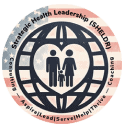Are your health system’s leaders fluent in AI, or just reacting to it?
Discover why mastering AI is now essential for visionary health leaders driving change, innovation, and better outcomes across their organizations.
Executive Summary: Health leaders must master strategic AI. Leaders who understand AI’s mechanics, ethics, and governance can improve care, lower costs, and protect access. These leaders use AI strategically by questioning outputs, encouraging innovation, and promoting change. Lacking AI fluency, leaders risk ethical failures, wasted investment, and trust loss. Tomorrow’s winners are practicing this to confidently guide their systems. Use links, questions, learning activities, and references to learn more.
Table of Contents
Introduction: Seize AI Now or Watch Others Win
In healthcare’s not-so-distant past, leaders were praised for their financial savvy, clinical understanding, and people management skills. Technical know-how was often relegated to IT departments. But today, artificial intelligence (AI) is rapidly emerging as a transformative force across clinical and administrative domains.
This shift means strategic AI fluency is no longer a “nice-to-have” for health leaders – it’s a core competency. In this article, we examine why being AI-ready is crucial for health executives and managers, what it entails in practice, and how leaders can develop the necessary skills to guide their organizations in the era of intelligence.
To lead effectively in this new era, health executives must stop viewing AI as a back-office tool and start seeing it as a strategic driver that reshapes every core function, starting now.
Harness AI: Transform Plans into Unmatched Impact
Forward-thinking organizations treat AI not merely as an IT project but as a strategic pillar in achieving their mission. AI can detect at-risk groups and predict population health management strategies. AI-savvy CEOs recognize that these abilities can help reduce hospitalizations and improve outcomes for patients with chronic illnesses.
In finance, AI can streamline supply chains and staffing to achieve operational excellence. When leaders understand AI’s potential, they can set a vision that integrates technology into every facet of strategy, from enhancing patient experience to driving value-based care performance.
In contrast, leaders without AI fluency might miss opportunities or, worse, pursue them clumsily without alignment to outcomes. In short, being conversant in AI allows leaders to harness it as a driver of change that they steer rather than a black box they react to.
However, recognizing AI’s strategic potential is only the first step—transformational impact depends on a leader’s ability to drive cultural adoption and manage resistance with clarity and conviction.
Break Resistance: Ignite Bold AI-Driven Innovation
Conservative healthcare culture resists new technology. AI-prepared leaders foster innovation and change while leading teams through transformation. Now we can clearly define AI and dispel myths about robots replacing workers and highlighting AI’s role in augmenting human work.
AI flags abnormal X-rays in radiology as a safety net, not a threat, say informed leaders. Using early adopter accuracy and workload reduction data, they can persuade clinicians with facts and empathy.
Change management experts provide extensive training and assistance, as deploying AI is as much about people as it is about technology. An AI-ready health leader may form an AI governance committee with clinicians, IT professionals, and ethicists to demonstrate shared ownership and resolve issues. By being knowledgeable and transparent about AI, leaders build trust, turning skeptics into stakeholders in the transformation process.
Innovation without accountability is dangerous—leaders must go beyond enthusiasm and develop the skill to rigorously interrogate AI outputs rather than relying on blind trust.
Stop Blind Trust: Demand Answers from Every Algorithm
A core skill of the AI-fluent leader is the ability to interpret AI outputs and ask the right questions about them. This skill doesn’t mean doing data science. However, it does mean understanding concepts such as what a risk score represents, the basics of how an algorithm learns its knowledge, and, importantly, its limitations.
For example, if an AI risk model indicates that a particular patient has a 30% chance of being readmitted, leaders should inquire about the data on which this assessment is based. Is there bias or something missing? They should determine if the model has been tested on a variety of patient groups to ensure it doesn’t consistently underestimate risk for certain groups, such as a well-known case where an algorithm undervalued care for Black patients.
By asking these probing questions, leaders hold their AI implementations to high standards and avoid blind trust in “the computer’s answer.” This competency is also critical during vendor selection – AI-ready leaders delve into how a product was developed, demanding evidence of clinical validity and fairness.
Essentially, they serve as translators between the technical and operational worlds, ensuring that AI tools address the intended problems ethically. Their strategic decisions—whether to allocate more resources to an AI-driven program or to pause one—are informed by this analytical approach to AI output.
Understanding how AI works is critical, but knowing when, why, and whether to use it requires something more profound: ethical fluency and a commitment to equity.
Lead with Integrity: Guard Fairness in AI Decisions
Hand-in-hand with technical understanding comes the moral responsibility of AI use. Health leaders must ensure AI is used ethically and advances health equity. An AI-ready leader champions fairness: they ask for bias audits of algorithms, just as they champion quality audits of clinical care.
They implement transparency policies to ensure that patients and staff are aware when AI is used in decision-making. They prepare to navigate dilemmas, such as how to handle situations when an AI recommendation conflicts with a clinician’s judgment, or addressing community concerns about privacy and surveillance with AI.
The group could set up an AI Ethics Board to look over AI projects and make sure they follow the rules. Strategic leaders can also affect policy by joining industry groups that help set AI guidelines or by pushing for smart rules that protect patients without getting in the way of new ideas.
In essence, AI fluency encompasses the ethical awareness to anticipate how technology might inadvertently exacerbate disparities or erode trust, and to proactively mitigate these risks. Leaders who can maintain public trust while driving technological advancements will have a competitive and reputational edge.
Stay Sharp: Evolve Fast or Risk Falling Behind
The AI landscape is evolving rapidly. Models improve, and new applications emerge seemingly every month. Thus, strategic AI fluency is not a one-time achievement but a commitment to continuous learning—a trait of any good leader, but now with a tech twist.
They’ll also be better prepared for the regulatory shifts likely to come, as described earlier, since they’re actively engaged with the field and can anticipate compliance needs or industry standards changes. Sustaining ethical, strategic AI leadership isn’t a one-time checklist—it demands continuous learning, agile adaptation, and a mindset built for change.
Lead Smarter: Make AI Fluency Your Winning Edge
Health leaders must become fluent in AI, not as technologists but as stewards of strategy, ethics, and transformation. AI fluency is no longer optional. It enables leaders to translate algorithmic power into real outcomes—better care, more intelligent decisions, and system-level innovation. Without this skill, leaders risk misalignment, ethical failures, and missed opportunities. Strategic fluency means knowing when to trust a model, when to question it, and how to lead human teams alongside it. Leaders must move beyond buzzwords and lead with confidence, clarity, and competence in the era of AI. 3 Actions SHELDRs must take now:
- Audit Your AI Readiness: Assess current leadership knowledge and pinpoint key gaps in AI fluency.
- Launch AI Governance Training: Ensure leaders understand bias, validation, and use-case fit before approving any AI deployment.
- Host an Executive AI Simulation: Walk through real scenarios using AI outputs to build judgment, ethics, and critical questioning.
Leading Decisively in the AI Era: Are You Truly Ready?
Strategic AI fluency has become the defining edge for health leaders determined to thrive—not just survive—in this decade. This article cuts through the hype and explains why learning about AI isn’t just about writing code; it’s also about being a better leader, asking better questions, and keeping your company’s moral compass in check. AI is quickly changing how we predict risk, distribute resources, and even measure trust. Without a clear understanding of its strengths and blind spots, leaders risk compromising patient outcomes, organizational reputation, and community trust.
Those who build fluency now will translate complex data into actionable strategies, embed equity safeguards before harm occurs, and champion a culture where technology serves—not dictates—care. Those who hesitate will watch competitors set new benchmarks for value, safety, and innovation while they scramble to keep up.
So ask yourself: Will you be the leader who questions AI deeply, governs it wisely, and channels it toward your mission—or will you let the algorithm steer without your hand on the wheel?
Consider the discussion questions and learning activities, then check out these articles at the Strategic Health Leadership (SHELDR) website:
Propel Yourself Upward: The New 80/20 Rule Meets ChatGPT as A Strategic Health Leader’s Game-Changer
Deep Dive Discussion Questions
- Where have we seen poor AI oversight erode healthcare trust, and how could strategic fluency have prevented it?
- How can your organization’s AI governance structures be more transparent to patients and staff?
- What are the most dangerous myths your teams believe about AI, and how will you correct them?
- How should we be auditing AI tools today to protect vulnerable populations tomorrow?
- How might reverse mentorship accelerate your executive team’s comfort and curiosity with AI?
Professional Development & Learning Activities
- Reverse AI Mentorship Circles: Pair senior executives with early-career, tech-savvy staff for monthly sessions that explore AI dashboards, ethics scenarios, and patient impact stories.
- AI Ethics War Room: Run a rapid-fire workshop where leaders debate tricky AI cases, from privacy dilemmas to biased risk scores, then draft actionable policy responses.
- Leadership Journal: AI Reflections: Have each leader keep a weekly AI leadership journal answering: What did I learn? What did I question? What will I change?
Videos
- AI Stethoscopes, Mayo Clinic Platform, HIMSS 2024. YouTube. https://www.youtube.com/watch?v=abcdef
- “Revolutionizing Healthcare in the Age of AI.” Lloyd Minor, MD. Stanford Medicine.
- How Artificial Intelligence Is Revolutionizing Health Care, Deloitte Digital
Hashtags
#AILeadership
#HealthTechStrategy
#AIFluency
#SmartHealthLeaders
#FutureReadyHealthcare




